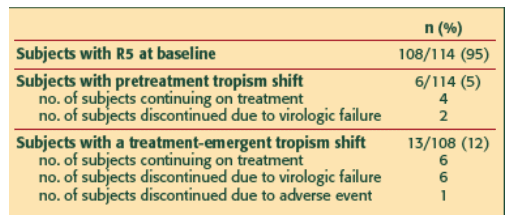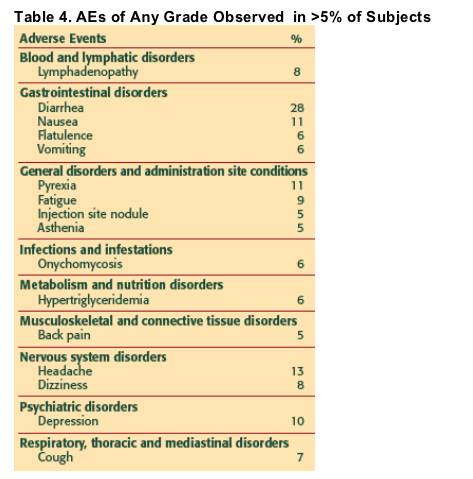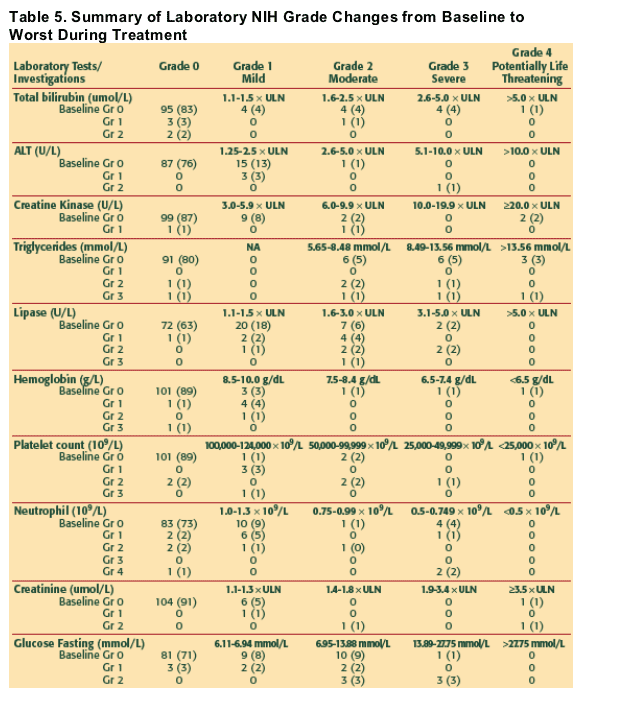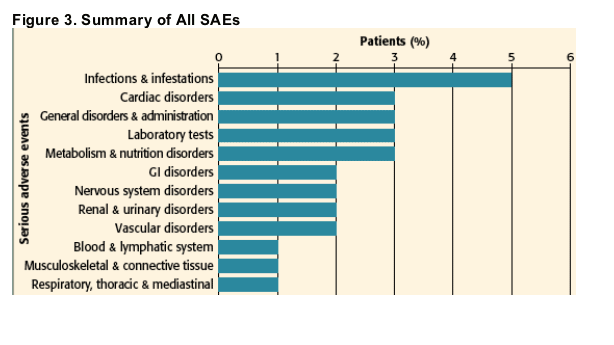 |
 |
 |
| |
Safety of Vicriviroc in ARt-Experienced Subjects: 12-Week VICTOR-E1 Results With Updated 24-Week Data
|
| |
| |
Reported by Jules Levin
4th IAS Conference, July 2007, Sydney
Jihad Slim, MD1, Ricardo Sobhie Diaz, MD, PhD2, Edwin DeJesus3, Jamal Muhamad Abdul Hamid
Suleiman, MD4, Lisa Dunkle5, and Daniel Alvarez5
1St. Michael's Medical Center-Infectious Diseases, Newark, NJ, USA; 2Laboratorio de Retrovirologia,
Sao Paulo, Brazil; 3Orlando Immunology Center, Orlando; 4Brazilmed Assistencia Medica e Pesquisa
S/C Ltda, Sao Paulo, Brazil; 5Schering-Plough Research Institute, Kenilworth, NJ, USA
AUTHOR SUMMARY
--Pooled data from this 24-week analysis indicates vicriviroc was well tolerated
--No evidence of safety concerns regarding cardiac toxicity, hepatotoxicity, drug related seizures, infections or malignancy
--The profile of adverse events was consistent with OBT and the data from recent phase 3 trials in treatment-experienced subjects2,3
--Tropism shifts were not associated with immune decline; CD4 counts were generally sustained or increased
--An independent data and safety monitoring board has recommended that
this trial continue
ABSTRACT
Objectives: Vicriviroc is a small-molecule CCR5 antagonist in clinical development. VICTOR-E1 is a randomized, double-blind, placebo-controlled dose-finding study comparing once daily (QD) vicriviroc, at higher doses than studied before, vs placebo in combination with a ritonavir- / protease
inhibitor (PI)-containing optimized antiretroviral therapy (ART) regimen in antiretroviral-experienced subjects with CCR5-tropic HIV-1. We will report the 12-week safety results.
Methods: Eligible subjects were failing current stable antiretroviral therapy (ART) and were 3-class ART experienced, with genotypically documented NRTI and PI resistance. Subjects had HIV viral load >1,000 copies/mL, no CNS abnormalities, acceptable laboratory values, and R5-tropic only virus (Trofile) at screening. Subjects were randomized to receive vicriviroc 20 mg, 30 mg, or placebo and
were prescribed an optimized background antiretroviral regimen that included a ritonavir-containing PI. Subjects were assessed for adverse events throughout treatment.
Results: 116 subjects were enrolled at 60 sites in 12 countries between June and November 2006. Mean age at enrollment was 44.9 years, and 22% were women. Mean baseline viral load and CD4 count were 5.2 log10 copies/ml and 219 cells/mm3, respectively. Trofile change from R5 to D/M occurred in 6 subjects between screening and Day 1 (prior to study drug). Mean duration of treatment
was ͠14 weeks (range 12-28). The blinded review of safety data shows no safety concerns, specifically no hepatotoxicity, malignancies, or drug-related seizures. Unblinded data are being reviewed by an independent DSMB.
Conclusions: Vicriviroc 20 mg and 30 mg administered once daily in combination with a ritonavir- / PI-containing ART regimen appears to be well tolerated in this treatment-experienced population.
CHANGES IN HIV TROPISM
Table 6. Summary of Tropism Shifts
Treatment-emergent tropism shifts generally did not result in decreased
CD4 cells; CD4 counts were for the most part sustained or increased.
None of these subjects has had a significant immunologic decline
(defined as >50% decline in CD4 count)

OVERALL ADVERSE EVENTS (AEs) in >5% of Subjects
- Adverse events of any severity were recorded in 105 (92%) subjects; most were mild-moderate in severity
- Grade 3/4 events occurred in only 8% of subjects
- A total of two (2%) subjects discontinued due to adverse event; one
subject discontinued due to pneumonia and the other discontinued due to
progression of CNS lesions
- Three (3%) subjects reported a cardiac-related event with no individual adverse
event occurring in >1% of subjects. No hypotension treatment emergent
adverse events were reported
- Herpes-related infections occurred in 3 (3%) subjects. No individual adverse
event occurred in >1% of subjects; herpes simplex 1 (1%), herpes virus infection 1 (1%), herpes zoster 1 (1%)
- Upper respiratory tract infection occurred in 4 (4%) subjects
- Some adverse events may be commonly seen with PIs in particular ritonavir
- No unexpected toxicities were observed across all subjects

LABORATORY ABNORMALITIES
No evidence of VCV-related hepatotoxicity
--One subject experienced a grade 3 elevation in ALT
--Five subjects experienced grade 3/4 shifts in total bilirubin; four subjects had a grade 3 shift and one had a grade 4 shift
--All subjects with grade 3/4 shifts had atazanavir in OBT
Grade 3/4 laboratory abnormalities were rare

SERIOUS ADVERSE EVENTS (SAEs)
- Overall 13 (11%) of subjects participating in the trial reported at least one SAE
- Six (5%) subjects reported an infection or infestation related SAE with no individual SAE occurring in >1% of subjects. Reported events included those commonly associated with advanced HIV: anogenital warts, bacterial diarrhea, gastrointestinal infection, oral candidiasis, pneumonia, pneumonia primary atypical, upper respiratory infection and urosepsis
- Three (3%) subjects reported cardiac related SAEs. No individual SAE occurred in >1% of subjects. Reported events were acute coronary syndrome, cardiopulmonary failure and pericarditis uraemic

|
| |
|
 |
 |
|
|